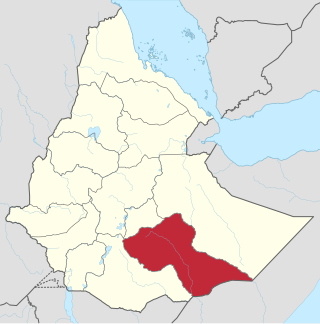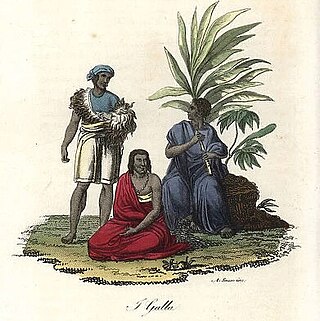
The Adal Sultanate also known as the Adal Empire, or Bar Saʿad dīn was a medieval Sunni Muslim Empire which was located in the Horn of Africa. It was founded by Sabr ad-Din III on the Harar plateau in Adal after the fall of the Sultanate of Ifat. The kingdom flourished c. 1415 to 1577. At its height, the polity under Sultan Badlay controlled the territory stretching from Cape Guardafui in Somalia to the port city of Suakin in Sudan. The Adal Empire maintained a robust commercial and political relationship with the Ottoman Empire. Sultanate of Adal was alternatively known as the federation of Zeila.

Ogaden is one of the historical names used for the modern Somali Region which forms the eastern portion of Ethiopia and borders Somalia. It includes another region in the north known as the Haud.

Bale, also known as Bali, is the name of two former polities located in the southeastern part of modern Ethiopia.

The Sultanate of Ifat, known as Wafāt or Awfāt in Arabic texts, or the Kingdom of Zeila was a medieval Sunni Muslim state in the eastern regions of the Horn of Africa between the late 13th century and early 15th century. It was formed in present-day Ethiopia around eastern Shewa in Ifat. Led by the Walashma dynasty, the polity stretched from Zequalla to the port city of Zeila. The kingdom ruled over parts of what are now Ethiopia, Ogaden, Djibouti, Somaliland or Somalia.

The Hawiye is the largest Somali clan family. Members of this clan traditionally inhabit central and southern Somalia, Somaliland, Djibouti, Ethiopia and Kenya. They are also the majority in the capital city, Mogadishu.
Hadiya also known as Adea or Hadia was a medieval Muslim state in the southern part of its realm located south of Shewa and west of Sharkha. The Hadiya Muslim state mainly composed of Cushitic Hadiyya proper, Halaba, Kebena people as well as Semitic Sil'te and other tongues related to Harari language. Hadiya was historically a vassal state of the Adal federation and then became an autonomous province of Abyssinia in the fourteenth century while still remaining a member of the Zeila union. In the 1600s Hadiya regained its independence and was led by a Garad. By 1850, Hadiya is placed north-west of lakes Zway and Langano but still between these areas.
Hadiya, also spelled as Hadiyya, is an ethnic group native to Ethiopia in Southern Nations, Nationalities and Peoples' Region who speak the Hadiyyisa language. According to a popular etymology, the name 'Hadiyya," sometimes written in the versions Hadya, Hadea, Hadija, Hadiyo, Hadiyeh, Adea, Adia, means "gift of god" A historical definition of the Hadiya people based on the old Hadiyya Sultanate included a number of Ethiopian ethnic groups currently known by other names. Currently, this historic entity is subdivided into a number of ethnonyms, partly with different languages and cultural affiliations. In his book "A History of the Hadiyya in Southern Ethiopia," Ulrich Braukämper reported that Leemo, Weexo-giira, Sooro, Shaashoogo, Baadawwaachcho, and Libido (Maraqo) Hadiyya, Endegang subgroups remain a language entity and preserved identity of oneness, the Hadiyya proper. The term Hadiya specifically designates the Qabeena people. Other ethnic groups such as Siltʼe, Wulbareg, Azarnat, Barbare, Wuriro, Wolane and Gadabano profess that they're the seven Hadiya clans. Ancient Hadiyans are distinguished by their Muslim heritage however these populations have decreased in the following centuries. Clans of Hadiya origin in Oromia, Sidama, Wolayta, Gurage, Tigray, and Afar were completely absorbed by these nations. They were initially all inhabitants of a single political entity, a sultanate, which in the four centuries following its break-up in the mid-16th century fragmented into separate ethnic groups.

The Harari people are a Semitic-speaking ethnic group which inhabits the Horn of Africa. Members of this ethnic group traditionally reside in the walled city of Harar, simply called Gēy "the City" in Harari, situated in the Harari Region of eastern Ethiopia. They speak the Harari language, a member of the South Ethiopic grouping within the Semitic subfamily of the Afroasiatic languages.

Arsi Oromo is an ethnic Oromo branch, inhabiting the Arsi, West Arsi and Bale Zones of the Oromia Region of Ethiopia, as well as in the Adami Tullu and Jido Kombolcha woreda of East Shewa Zone.The Arsi are made up of the Sikkoo-Mandoo branch of Barento Oromo. The Arsi in all zones speaks Oromo share the same culture, traditions and identity with other subgroup Oromo.
Sharka was a province of the Ethiopian Empire in the southern part of its realm. Its inhabitants were predominantly Muslim, and similar in customs, economic conditions, and ethnic affiliations to its neighboring provinces of Hadiya and Arababni.

Sheikh Hussein was a 13th-century Somali Muslim proselytizer who lived in Ethiopia and was from the famous port town of Merca in Somalia, one of the power jurisdictions and cultural centers of the Ajuran Sultanate. He is now honored as a saint.

The Oromo expansions, also known as the Oromo migrations or the Oromo invasions, were a series of expansions in the 16th and 17th centuries by the Oromo. Prior to their great expansion in the 16th century, the Oromo inhabited only the area of what is now modern-day southern Ethiopia and northern Kenya. Over the centuries due to many factors, mostly the wars between Adal Sultanate and Ethiopia would further encourage the numerous Oromo tribes to expand towards central and eastern modern Ethiopia.

The Makhzumi dynasty also known as Sultanate of Shewa or Shewa Sultanate, was a Muslim kingdom in present-day Ethiopia. Its capital Walale was situated in northern Hararghe in Harla country. Its territory extended possibly to some areas west of the Awash River. The port of Zeila may have influenced the kingdom. The rise of the Makhzumi state at the same time resulted in the decline of the Kingdom of Axum. Several engravings dating back to the 13th century showing the presence of the kingdom are found in Chelenqo, Bale, Harla near Dire Dawa and Munesa near Lake Langano.
The Jaarso, Giarso or Jaarsoo is a northern Somali clan, a sub-division of the Dir clan family. They largely live in Ethiopia, in the Oromo Region and the Somali Region, especially in and around the ancient cities of Chinaksen, Harar and between Mieso and Jigjiga.
Dawaro or Doaro was a Muslim principality which laid alongside the Ifat Sultanate. The state was originally independent until becoming a vassal and later a province due its subjugation by Emperor Amda Seyon I in the early 14th century. The region was situated east of Hadiya and north of Bali which covered much of Ethiopia's Arsi Province.The capital of Dawaro was called Sabboch

Fatagar was a historical province that separated Muslim and Christian dominions in the medieval Horn of Africa. In the eleventh century it was part of the Muslim states, then was invaded by the Christian kingdom led by Emperor Amda Seyon I, after which it would serve as central district in, and home of multiple rulers of, the Ethiopian Empire in the 15th century.
The Gaturi, also spelled as Gatouri are an extinct ethnic group that once inhabited present-day eastern Ethiopia.

Gidaya, also known as Gedaya or Jidaya was a historical Muslim state located around present-day eastern Ethiopia. The state was positioned on the Harar plateau and a district of Adal region alongside Hargaya and Hubat polities. It neighbored other states in the medieval era including Ifat, Mora, Hadiya, Fatagar, Biqulzar and Fedis.
Adal, known as Awdal or Aw Abdal was a historical Muslim region in the Horn of Africa. Located east of Ifat and the Awash river as far as the coast, and including Harar as well as Zeila. The Zeila state often denoted Adal and other Muslim dominions in medieval texts.
Zeila also known as Zaila or Zayla was a historical Muslim region in the Horn of Africa. The region was named after the port city of Zeila in modern day Somalia.











